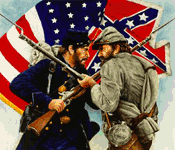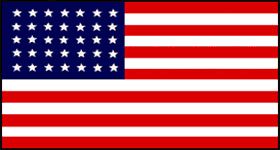 |
Civil War Battles |
|
State War Records |
| AL - AK - AZ - AR - CA - CO - CT - DE - FL - GA - HI - ID - IL - IN - IA - KS - KY - LA - MA - MD - ME - MI - MN - MS - MO - MT - NE - NV - NH - NJ - NM - NY - NC - ND - OH - OK - OR - PA - RI - SC - SD - TN - TX - UT - VT - VA - WA - WV - WI - WY |
The Battle of Camp Wildcat
October 21, 1861 in Laurel County, Kentucky
 |
|||||||||||||||||||
|
In the summer of 1861, Kentucky was officially neutral, but both the North and South were recruiting soldiers from the state. The South was concerned that Union troops being recruited would invade east Tennessee. The North worried that Confederate troops would move into Kentucky in an effort to control the Bluegrass region, thereby gaining access to the Ohio River.
The main artery of travel in eastern Kentucky was the Wilderness Road. Control of this artery also meant control of mountaineers whose sentiments were pro-Union.
In July of 1861, General Felix Zollicoffer assumed command of Confederate troops in Bristol, Tennessee. His task was to organize regiments plagued by confusion and to prevent a Union invasion of east Tennessee.
That same month in Kentucky, Colonel Theophilous Garrard, grandson of the former governor, was given command of a Union regiment that existed only on paper. He set up a recruiting station near his home town of Manchester. By the end of August, he had enlisted nearly a thousand men.
On the 9th of September, Confederate General Zollicoffer ordered his troops to move into Kentucky through the Cumberland Gap. Within ten days, his troops, which numbered 5,400 men, took possession of the Cumberland Ford at Pineville, Kentucky and defeated a group of home guard volunteers from the town of Barbourville.
On September 23, distressing news for Union forces reached Camp Dick Robinson near Lancaster, Kentucky, where Colonel Garrard was just beginning to assemble his regiment. Advanced units of Zollicoffer's forces had already reached the Laurel River outside of London.
Garrard's poorly outfitted soldiers were rushed forward to the Wilderness Road. They were ordered to guard a ford across the Rockcastle River in the rugged Rockcastle Hills. The 1st Kentucky Cavalry, which was sent ahead of them, was also less than battle ready. Training had consisted of little more than instructions on how to shoot a musket.
Garrard's troops established camp on a ridge three miles above the south side of the Rockcastle River at a fork in the road. It was named Camp Wildcat. On September 29, Garrard reported that the Laurel County Home Guard had been routed at the Laurel River and were straggling into his camp. His report included evidence of the inadequate training given the new recruits.
"One of Wolford's men fired upon another of his men, wounding Bailey in the arm and killing one horse and wounding another. The private who shot himself at camp... died yesterday."
The next day Garrard sent an urgent request asking for uniforms, blankets, and coats for his 975 men.
While Garrard was preparing Camp Wildcat, Confederate troops continued their push northward. Travel was slowed by a lack of forage and the poor condition of the road. Later, in his report on the battle, General Zollicoffer wrote,
"The country is so poor we had exhausted the forage on the road for 15 miles back in twenty-four hours."
Still, by October 17th his entire force had reached the Laurel River.
As Zollicoffer's troops advanced, Garrard's requests for aid became more desperate:
"...if I do not receive more troops (I intend) to abandon this place... I have no idea of having my men butchered up here where they have a force of six to one... I would like to hear from you immediately."
On October l9th, with time running out, Brigadier General Albin Scheopf was ordered to take command of Camp Wildcat. Coming with him were the reinforcements Garrard had so urgently requested. Troops from the 33rd Indiana Infantry, 17th, 14th and 38th Ohio Infantries, and Battery B of the Ohio Light Artillery were ordered to move to the camp as quickly as possible.
The 1st and 2nd East Tennessee (USA) were also enroute. In order to reach Wildcat before the Confederates, they had to negotiate roads so deep with mud that it reached the axles on their wagons.
Zollicoffer's force passed London on October 20th, and advanced rapidly toward Garrard's undermanned position. Fortunately for Garrard, Union reinforcements began arriving late that morning. By nightfall, Camp Wildcat had a new commander and more than triple the number of troops that were present when the day began.
It was their first battle. All their faces wore a serious expression. "There was a shade of dread on all countenances, while some showed cool determination, others were excited and tremulous." wrote Eastham Tarrant, 1st Kentucky Cavalry.
Early on the morning of October 21, Confederate troops began making their way up wooded slopes toward a knob held by the 33rd Indiana Infantry. The attack began about nine o'clock.
It wasn't long until the woods were filled with the smell of gun powder and the cries of charging soldiers. Fire from both sides was intense.
Ten minutes after the first rounds were exchanged, Union Colonel John Coburn, commander of the 33rd Indiana, received a glimpse of how many soldiers his men were facing. Coburn wrote,
"They were in large numbers, and were over half-an-hour in passing by an open space in the woods."
As the fighting raged, the 1st Kentucky Cavalry came up to assist the Union troops. The men dismounted, but wavered and almost panicked before being rallied. Later the 14th and 17th Ohio Infantry moved up and joined the battle.
After an hour-and-a-half of fierce firing at close range, Confederate Colonel Tazwell Newman, who was leading the 17th Tennessee Infantry, ordered four of his companies to charge the Union position. They rushed up the hill with bayonets flashing. The colonel described what happened next:
"After fortification was reached and many of my men had got within the works....not receiving any support, and being nearly destitute of cartridges, I ordered my command to fall back."
A second offensive was mounted in the afternoon. According to one account, Confederate forces, supported by artillery, made an attempt to move up the Wilderness Road toward Camp Wildcat but were repelled. A correspondent for the Cincinnati Gazette wrote,
"(Zollicoffer's) attack was unsuccessful, simply because it came 24 hours too late."
UUnion forces spent that night fortifying their entrenchments for an attack that never came. Late in the night the sound of beating drums and moving Confederate wagons rose from the valley floor. When the sun rose, the valley was empty.
Zollicoffer wrote,
"Having reconnoitered in force under heavy fire for several hours from heights on the right, left, and front, I became satisfied that it could not be carried otherwise than by immense exposure... I deemed it proper the next day to fall back."
The battle of Camp Wildcat was over.
The inexperience of both Union and Confederate soldiers and the cover provided by the heavily wooded terrain helped keep the number of casualties low.
General Schoepf reported four Union soldiers killed and eighteen wounded. General Zollicoffer reported eleven killed and forty-two wounded or missing from the Confederate side. However, the aftermath of the battle proved more deadly that the assault itself.
Twelve of 21 Union prisoners taken by General Zollicoffer died within six months. Measles and fever took a heavy toll. The 33rd Indiana alone lost at least fifty men to sickness and hundreds of others were reported ill within a few weeks of the battle. Like Private McFerren, their battles were over. For the rest of the country, the war lasted for four more years.
| UNION | CONFEDERATE |
|---|---|
|
|
